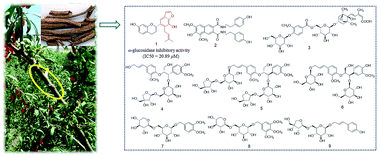Nine new compounds from the root bark of Lycium chinense and their α-glucosidase inhibitory activity†
Abstract
Lycium chinense Mill. is a deciduous shrub in the Solanaceae family that is known for its fruits (Lycii fructus) and root bark (Lycii cortex). In our ongoing search for α-glucosidase inhibitors from the root bark of L. chinense, lyciumflavane A, one new flavane with an unusual benzofuran unit, one new amide possessing a naphthalene skeleton, one new sesquiterpene, three new lignan glucosides, and three new phenolic glucosides were isolated along with eight known compounds. Their structures were elucidated using NMR, HRESIMS, UV, ECD, and IR spectroscopic data. Their α-glucosidase inhibitory activity was screened using acarbose as a positive control (IC50 = 385 μM). Compound 1 showed strong inhibitory activity against α-glucosidase (IC50 = 20.89 μM).


 Please wait while we load your content...
Please wait while we load your content...